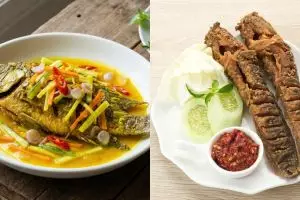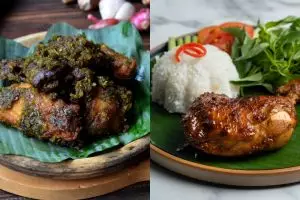foto: pixabay.com
Contoh soal explanation text pilihan ganda.
Teks Explanation 1
Acid rain is rain that is highly acidic because of sulfur oxides, nitrogen oxides, and other air pollutants dissolved in it. Normal rain is slightly acidic, with a pH of 6. Acid rain may have a pH value as low as 2.8.
Acid rain can severely damage both plant and animal life. Certain lakes, for example, have lost all fish and plant life because of acid rain.
Acid rain comes from sulfur in coal and oil. When they burn, they make sulfur dioxide (SO2 ). Most sulfur leaves factory chimneys as the gaseous sulfur dioxide (SO2 ) and most nitrogen are also emitted as one of the nitrogen oxides (NO or NO2 ), both of which are gasses. The gasses may be dry deposited–absorbed directly by the land, by lakes or by the surface vegetation. If they are in the atmosphere for anytime, the gasses will oxidize (gain an oxygen atom) and go into solution as acids. Sulphuric acid (H2 SO4 ) and the nitrogen oxides will become nitric acid (HNO3 ). The acids usually dissolve in cloud droplets and may travel great distances before being precipitated as acid rain.
Catalysts such as hydrogen peroxide, ozone, and ammonium help promote the formation of acids in clouds. More ammonium (NH4 ) can be formed when some of the acids are partially neutralized by airborne ammonia (NH3 ). Acidification increases with the number of active hydrogen (H+) ions dissolved in acid. Hydrocarbons emitted by, for example, car exhausts will react in sunlight with nitrogen oxides to produce ozone. Although it is invaluable in the atmosphere, low-level ozone causes respiratory problems and also hastens the formation of acid rain.
When acid rain falls on the ground it dissolves and liberates heavy metals and aluminum (Al). When it is washed into lakes, aluminum irritates the outer surfaces of many fish. As acid rain falls or drains into the lake the pH of the lake falls. Forests suffer the effect of acid rain through damage to leaves, through the loss of vital nutrients, and through the increased amounts of toxic metals liberated by acid, which damage roots and soil microorganisms.
1. What is the text mainly about?
A. The definition of acid rain
B. The process of acid rain
C. The effect of acid rain
D. Acid rain
E. Rain
Jawaban: D
2. The acid of normal rain is .… then the acid rain
A. Higher
B. Lower
C. Denser
D. Severer
E. The same
Jawaban: B
3. What is the result of the burning of the coal and oil?
A. Ammonium
B. Nitric acid
C. Sulphuric acid
D. Sulfur dioxide
E. Airborne ammonia
Jawaban: D
4. The sulfur oxides and nitrogen oxides will …. in the air.
A. Be absorbed directly by the vegetation
B. Dissolved in the lake water and land
C. Emit another sulfur gas
D. Radiate an oxygen atom
E. Gain an oxygen atom
Jawaban: E
5. Which of the following is not true about acid rain?
A. It contains lower pH than the normal rain
B. It has higher pH than the normal rain
C. It can damage animal and plant life
D. It contains dangerous gasses
E. It endangers water life
Jawaban: A
6. What is the purpose of the text?
A. To report the acid rain in general
B. To explain the process of acid rain
C. To persuade the reader to prevent acid rain
D. To discuss the danger of acid rain in the air
E. To present two different opinions on acid rain process
Jawaban: B
Teks Explanation 2
Have you ever wondered how people get chocolate from? In this article we’ll enter the amazing world of chocolate so you can understand exactly what you’re eating.
Chocolate starts with a tree called the cacao tree. This tree grows in equatorial regions, especially in places such as South America, Africa, and Indonesia. The cacao tree produces a fruit about the size of a small pine apple. Inside the fruit are the tree’s seeds, also known as cocoa beans.
The beans are fermented for about a week, dried in the sun and then shipped to the chocolate maker. The chocolate maker starts by roasting the beans to bring out the flavour. Different beans from different places have different qualities and flavor, so they are often sorted and blended to produce a distinctive mix. Next, the roasted beans are winnowed. Winnowing removes the meat nib of the cacao bean from its shell. Then, the nibs are blended. The blended nibs are ground to make it a liquid. The liquid is called chocolate liquor. It tastes bitter. All seeds contain some amount of fat, and cacao beans are not different. However, cacao beans are half fat, which is why the ground nibs form liquid. It’s pure bitter chocolate.
7. The text is about …
A. the cacao tree
B. the cacao beans
C. the raw chocolate
D. the making of chocolate
E. the flavour of chocolate
Jawaban: D
8. The third paragraph focuses on …
A. the process of producing chocolate
B. how to produce the cocoa flavour
C. where chocolate comes from
D. the chocolate liquor
E. the cacao fruit
Jawaban: A
9. ” …, so they are often sorted and blended to produce …” (Paragraph 3.) The word “sorted “is close in meaning to …
A. arranged
B. combined
C. separated
D. distributed
E. organized
Jawaban: C
10. How does the chocolate maker start to make chocolate?
A. By fermenting the beans.
B. By roasting the beans
C. By blending the beans.
D. By sorting the beans.
E. By drying the beans
Jawaban: B
Teks Explanation 3
Recycling is a collection, processing, and reuse of materials that would otherwise be thrown away. Materials ranging from precious metals to broken glass, from old newspapers to plastic spoons, can be recycled. The recycling process reclaims the original material and uses it in new products.
In general, using recycled materials to make new products costs less and requires less energy than using new materials. Recycling can also reduce pollution, either by reducing the demand for high-pollution alternatives or by minimizing the amount of pollution produced during the manufacturing process.
Paper products that can be recycled include cardboard containers, wrapping paper, and office paper. The most commonly recycled paper product is newsprint. In newspaper recycling, old newspapers are collected and searched for contaminants such as plastic bags and aluminum foil.
The paper goes to a processing plant where it is mixed with hot water and turned into pulp in a machine that works much like a big kitchen blender. The pulp is screened and filtered to remove smaller contaminants. The pulp then goes to a large vat where the ink separates from the paper fibers and fl oats to the surface. The ink is skimmed off, dried and reused as ink or burned as boiler fuel. The cleaned pulp is mixed with new wood fibers to be made into paper again.
Experts estimate the average office worker generates about 5 kg of wastepaper per month. Every ton of paper that is recycled saves about 1.4 cu m (about 50 cu ft) of landfill space. One ton of recycled paper saves 17 pulpwood trees (trees used to produce paper).
11. The following things can be recycled, EXCEPT….
A. Precious metals
B. Broken glass
C. Old newspapers
D. Plastic spoons
E. Fresh vegetables and fruits
Jawaban: E
12. Which of the following is NOT the benefit of recycling?
A. It costs much money for the process of recycling
B. It costs less to make new products
C. It requires less energy
D. It can reduce pollution
E. It reduces the demand for high-pollution alternatives
Jawaban: E
13. What is the third step of recycling paper products?
A. Collect and search for contaminants such as plastic bags and aluminium foil
B. Mix the paper with hot water in a blender which turns it into pulp
C. Screen and filter the pulp to remove smaller contaminants
D. Put the pulp to a large vat to separate the ink from the paper fibres
E. Mix the pulp with new wood fibres to be made into paper again
Jawaban: C
14. We can make use of the ink after being separated from the paper fibres by doing the followings, EXCEPT….
A. Skim it off
B. Dry it
C. Reuse as ink
D. Burn as boiler fuel
E. Mix it with the pulp
Jawaban: E
Teks Explanation 4
What is photosynthesis? Photosynthesis is a food-making process that occurs in green plants. It is the chief function of leaves. The word photosynthesis means putting together with light. Green plants use energy from light to combine carbon dioxide and water to make sugar and other chemical compounds.
How is the light used in photosynthesis?
The light used in photosynthesis is absorbed by a green pigment called chlorophyll. Each food-making cell in a plant leaf contains chlorophyll in small bodies called chloroplasts. In chloroplast, light energy causes water drawn form the soil to split into hydrogen and oxygen.
What are the steps of photosynthesis process?
Let me tell you the process of photosynthesis, in a series of complicated steps, the hydrogen combines with carbon dioxide from the air, forming a simple sugar. Oxygen from the water molecules is given off in the process. From sugar together with nitrogen, sulphur, and phosphorus from the soil-green plants can make starch, fat, protein, vitamins, and other complex compounds essential for life. Photosynthesis provides the chemical energy that is needed to produced these compounds.
15. What step after the hydrogen combines with carbon dioxide from the air …
A. Photosynthesis provides the chemical energy that is needed to produced these compounds.
B. Water drawn form the soil to split into hydrogen and oxygen.
C. Food-making process that occurs in green plants.
D. Phosphorus from the soil-green plants can make starch, fat, protein, vitamins, and other complex compounds essential for life.
E. Oxygen from the water molecules is given off in the process.
Jawaban: E
16. What are photosynthesis need …
A. Water, light, oxygen, worm
B. Soil, chlorophyll, sun, human
C. Bug, air, oxigen, food
D. Light, Carbon dioxide, humus
E. Candle, vitamins, hydrogen
Jawaban: D
17. What the product of photosynthesis …
A. Sugar
B. Food and O2
C. Root
D. Food
E. Branch
Jawaban: B
18. What kind of the text …
A. Narrative text
B. Hortatory text
C. Discussion text
D. Explanation text
E. Descriptive text
Jawaban: D
Teks Explanation 5
Human body is made up of countless millions of cells. Food is needed to built up new cells and replace the worn out cells. However, the food that we take must be changed into substances that can be carried in the blood to the places where they are needed. This process is called digestion.
The first digestive process takes place in the mouth. The food we eat is broken up into small pieces by the action of teeth, mixed with saliva, a juice secreted by glands in the mouth. Saliva contains digestive juice which moisten the food, so it can be swallowed easily.
From the mouth, food passes through the esophagus (the food passage) into the stomach. Here, the food is mixed with the juices secreted by the cells in the stomach for several hours. Then the food enters the small intestine. All the time the muscular walls of the intestine are squeezing, mixing and moving the food onwards.
In a few hours, the food changes into acids. These are soon absorbed by the villi (microscopic branch projections from the intestine walls) and passed into the bloodstream.
19. What is the text about?
A. The digestive system
B. The digestive juice
C. The method of the digestive system
D. The process of intestine work
E. The food substances
Jawaban: A
20. How can we swallow the food easily?
A. The food changes into acids absorbed by the villi.
B. The food must be digested first through the process.
C. The food is directly swallowed through esophagus into the stomach.
D. The food is mixed with the juices secreted by the cells in the stomach.
E. The food we take must be changed into substances carried in the blood to the places.
Jawaban: B
21. From the text above, we imply that ….
A. a good process of digestive system will help our body becoming healthier.
B. no one concerned with the process of digestive system for their health.
C. the digestive system is needed if we are eating the food instantly.
D. every body must conduct the processes of digestive system well.
E. the better we digest the food we eat, the healthier we will be.
Jawaban: A
22. “Human body is made up of countless millions of cells.” (Paragraph 1) The phrase “made up” means ….
A. produced
B. managed
C. arranged
D. completed
E. constructed
Jawaban: E
Teks Explanation 6
A natural disaster is a terrible accident, e.g. a great flood, a big fire or an earthquake. It usually causes great suffering and loss of a large sum of money. The casualties are injured or died. Some people are homeless and need medical care.
Floods occur when the water of rivers, lakes, or streams overflow their banks and pour onto the surrounding land. Floods are caused by many different things. Often heavy rainstorms that last for a brief can cause a flood. But not all heavy storms are followed by flooding. If the surrounding land is flat and can absorb the water, no flooding will occur. If, however, the land is hard and rocky, heavy rain cannot be absorbed. Where the banks are low, a river may overflow and flood adjacent lowland.
In many part of the world flood are caused by tropical storms called hurricanes or typhoons. They bring destructive winds of high speed, torrents of rain, and flooding. When a flood occurs, the destruction to surrounding land can be severe. Whole villages and towns are sometimes swept away by water pouring swiftly over the land. Railroad track blocked and uprooted from their beds. Highways are washed away.
When a building caught fire, the firemen pitched in to help battle the blaze. Before the pumps were invented, people formed bucket brigades to fight fires. Standing side by side, they formed a human chain from the fire to nearby well or river. They passed buckets of water from to hand to be poured on the flames.
The damage of the fire did depend a great deal on where it happened. In the country or a small village, only a single house might burn down. But in crowded cities, fire often destroyed whole blocks and neighborhoods before being controlled. (Soal UN SMA/MA IPA 2011/2012)
23. What can possibly prevent rivers and lakes from overflowing?
A. An absorbent bed.
B. A rocky surrounding.
C. A low land.
D. A high bank
E. A high road.
Jawaban: D
24. We know from the text that . . . .
A. River can sweep heavy flood
B. People can make money from flood
C. The destruction by flood is always less severe
D. Water flood is absorbed by land
E. Typhoons caused heavy flood
Jawaban: D
25. We know from the text that . . . .
A. The pump is the only tool used by fire fighters now
B. The pump helps people to fight fires more efficiently
C. Fires in big cities are always very big
D. People no longer use buckets to control fire
E. Only firemen can control fires in crowded cities
Jawaban: B
Teks Explanation 7
Biodiesel is a clean burning substitute for petroleum based diesel fuel. Biodiesel is made of vegetable oil.
To make or manufacture Biodiesel, you must first start with raw materials. The raw materials needed in the production of Biodiesel are a small amount of methanol and a ready supply of vegetable product.
One of the most common vegetables used in the production of Biodiesel is corn, although depending on the geographic location of the manufacturing facility many other plants are used as well (rapeseed, soybeans, flaxseed, etc.). The first step is to use the raw vegetable product to make vegetable oil. Vegetable oil by itself will not be what you need to power a car, from here it has to be processed into Biodiesel.
The process for converting vegetable oil into Biodiesel is sometimes called ester interchange. To complete this process the vegetable oil has to be combined with a smaller amount of methanol and then put in the presence of a small quantity of an alkaline catalyst (for example, 5% to 1% sodium hydroxide). Vegetable oil is made up of so-called triglycerides, which is a compound of the trivalent alcohol glycerin with three fatty acids.
The goal of ester interchange is to separate the glycerin molecule from the three fatty acids and replace it with three methanol molecules. This process then yields roughly 90% Biodiesel and 10% of a glycerin byproduct. The glycerin byproduct can be used in a number of other chemical processes for different industries.
26. What is the text about?
A. The process of making Biodiesel
B. The use of the Biodiesel.
C. The advantage of using the Biodiesel.
D. The benefit of producing the Biodiesel.
E. The development of the Biodiesel product.
Jawaban: A
27. What are interchanged in the process of ester interchange?
A. The three fatty acids with the glycerin molecules.
B. The glycerin molecule with three methanol molecules
C. Methanol with the three fatty acids.
D. Vegetable oil with methanol
E. Methanol and alkaline catalyst.
Jawaban: B
28. According to the text, one of the advantages in using biodiesel is…
A. it is cheap.
B. it only uses vegetable oil.
C. it uses replaceable materials.
D. it can be done in small industry.
E. it gives less pollution than petroleum
Jawaban: E
29. “The process for converting vegetable oil…”(Paragraph 3). The word “converting” is closest in meaning to…
A. Producing
B. Separating
C. Attaching
D. Processing
E. Changing
Jawaban: E
Recommended By Editor
- 37 Contoh soal essay narrative text lengkap dengan jawabannya
- 129 Contoh kata benda dalam bahasa Inggris beserta artinya
- 50 Contoh soal descriptive text terlengkap beserta kunci jawabannya
- 25 Contoh soal procedure text Bahasa Inggris beserta kunci jawabannya
- 25 Contoh kalimat perbandingan bahasa Inggris (degree of comparison)

































